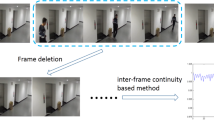Abstract
With the popularization of the network video, format conversion and de-interlacing are more required in video displaying and transmission. Field merge is perfect to de-interlace the film mode video sequence in which repeated fields or even/odd fields from the same film frame are contained. In this paper, inter-field difference is compared with a threshold, and repetition pattern of the result is utilized to determine the film mode. The threshold is set variable by tracking the local minimum difference of previous and subsequent fields. Film modes with repeated fields are identified using frame difference pattern. The 2-2 film mode is decided if forward and backward field differences jaggedly swing in opposite direction. Other film modes with fields from the same film frame are recognized by the combination of frame difference and forward field difference patterns. In this way, correct field merge is guaranteed after knowing which adjacent fields are decomposed from the same film frame. Experimental results show that various film modes in television systems, animations, camcorders and particularly interlaced network video can be correctly recognized by proposed method.
























Similar content being viewed by others
References
Brox P, Woestenberg L, De Haan G (2007) Local picture-repetition mode detector for video de-interlacing. IEEE Trans Consum Electron 53(4):1647–1655. doi:10.1109/TCE.2007.4429265
Chen QB, Sun HB, Yang J, Zhang NN (2012) A robust film-mode detection approach for digital TV SoC design. In: IEEE international conference on solid-state and integrated circuit technology, pp 1–3. doi:10.1109/ICSICT.2012.6466730
Christopher TJ, Correa C (1996) Method and apparatus for identifying video fields produced by film sources employing 2-2 and 3-2 pull down sequences. Assignee: Thomson Consumer Electronics, Inc., Indianapolis, Ind. United States Patent Office US 5563651, 8 Oct 1996
Communications Specialties, Inc. (2009) HDTV standards and practices for digital broadcasting. Available from http://www.cncsi.com/down.aspx?file=files/HDTV01.pdf. Accessed 28 June 2012
Han SH, Kim HK, Lee YH, Yang SJ (2005) Converting the interlaced 3: 2 pulldown film to the NTSC video without motion artifacts. In: IEEE international conference on image processing 2(II-1054-7). doi:10.1109/ICIP.2005.1530240
IDT (2012) Film cadence and video/film detection. Available from http://www.hqv.com/index.cfm?page=tech.cadence. Accessed 28 June 2012
Jia YW, Winger LL (2010) Unified approach to film mode detection. Assignee: LSI Corporation, Milpitas, CA (US). United States Patent Office US 7705913B2, 27 Apr 2010
Jia YW, Winger LL, Linzer EN (2007) Method for robust inverse telecine. Assignee: LSI Logic Corporation. United States Patent Office US 2007/0104273A1, 10 May 2007
Ku CC, Liang RK (2004) Robust layered film-mode source 3:2 pull down detection/correction. IEEE Trans Consum Electron 50(4):1190–1193. doi:10.1109/TCE.2004.1362518
Lin SF, Chang YL, Chen LG (2003) Motion adaptive interpolation with horizontal motion detection for deinterlacing. IEEE Trans Consum Electron 49(4):1256–1265. doi:10.1109/TCE.2003.1261227
özer N et al (2010) Film mode detection through optimal successive mode elimination. Applicant: Vestel Elektronik Sanayi ve Ticaret A.S. 45030 Manisa(TR). European Patent Office EP 2265010A2, 22 Dec 2010
Schutten RJ, De Haan G (1998) Real-time 2-3 pull-down elimination applying motion estimation/compensation in a programmable device. IEEE Trans Consum Electron 44(3):930–938. doi:10.1109/30.713216
Swan PL (2000) System and method for reconstructing non-interlaced captured content for display on a progressive screen. Assignee: ATI Technologies, inc., Thornhill, Canada. United States Patent Office US 6055018, 25 Apr 2000
Xu D, Swartz P (1994) Television signal processing apparatus incorporating means for detecting 25 frame/second motion picture film sources in 50 Hz television signals. Applicant: Faroudja YC, 26595 Anacapa Drive, Los Altos Hills, CA 94022(US). World Intellectual Property Organization, International Publication Number: WO94/30006, 22 Dec 1994
Yang S, Jung YY, Lee YH (2004) Motion compensation assisted motion adaptive interlaced-to-progressive conversion. IEEE Trans Circuits Syst Video Technol 14(9):1138–1148. doi:10.1109/TCSVT.2004.833163
Yuan Y, Liu YX, Liu ZH, Jiang XZ, Wang F (2012) A 2-2 pull-downed film mode detection and treatment method with scrolling subtitles. In: IEEE international symposium on broadband multimedia systems and broadcasting, pp 1–5. doi:10.1109/BMSB.2012.6264277
Author information
Authors and Affiliations
Corresponding author
Rights and permissions
About this article
Cite this article
Wang, W., Nie, T., Tu, Z. et al. A threshold-adaptive film mode detection method in video de-interlacing. Multimed Tools Appl 73, 1361–1389 (2014). https://doi.org/10.1007/s11042-013-1623-5
Published:
Issue Date:
DOI: https://doi.org/10.1007/s11042-013-1623-5




